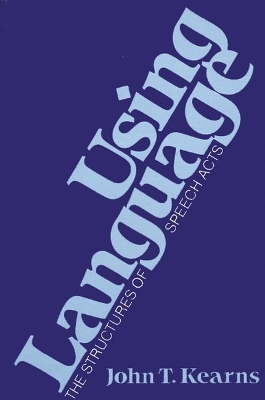
Using Language
State University of New York Press (Verlag)
978-0-87395-809-7 (ISBN)
The book begins by delineating a theory of the structures of intentional acts and then applies this to the special case of linguistic acts. Given an understanding of the meanings of component expressions, we can use our knowledge of linguistic structure to determine the meaning of a complex expression. An innovative discussion of semantics is subdivided into theories of three "semantic dimensions": representational meaning, inferential meaning, and truth conditions. Drawing upon these analyses the speech act theory of this book purposes that the meaning of a sentence (sentential act) is to be explained wholly in terms of the meanings of component expressions (acts) and the structure of the sentence.
John T. Kearns is Professor of Philosophy at the State University of New York, Buffalo. He is the author of Deductive Logic, A Programmed Introduction and numerous articles on logic and philosophy.
Acknowledgments
Introduction
1. A Speech-Act Theory
2. The More General Framework
3. The Plan of the Book
4. Some Other Views
1. Intentional Acts
1. Introduction
2. Acts for a Purpose
3. Completable and Completing Acts
4. Complex Acts
5. The Structures of Acts
6. Enabling Acts
7. Trying
8. Instrumental Acts
9. Developing a Theory
2. Linguistic Acts
1. Sentential Acts
2. Illocutionary Acts
3. Audience Participation
4. Habitual Acts
5. Plain and Consummated Acts
6. Propositional Acts
7. Tree Diagrams
3. The System of Language
1. Representational Meaning
2. Inferential Meaning
3. Accepting and Rejecting Sentences
4. Commitment
5. Semantic Features
4. The Role of Experience in the System of Language
1. Experience
2. The Levels of Experience
3. Taking To Be and Taking For
4. The Sentential Structure of Experience
5. First-Level Experience
6. Habitual Acts Again
7. The Structure of the System of Language
8. Systems of Language
5. Semantics
1. Significance with Respect to Experience
2. Experiential Connections
3. Semantics Is Possible
4. Semantic Theories
5. Theories of Representational Meaning
6. The Broader System of Language
6. Logical Form and Grammatical Form
1. The Original Distinction
2. Some Problems with the Distinction
3. Reformulating the Distinction
4. Additional Problems
7. Deep Structure, Surface Structure, Semantic Structure
1. Deep and Surface Structure
2. Abandoning the Linguist's Picture
3. Speech-Act Syntactic Structure
4. Speech-Act Structure Instead of Deep Structure
5. English Adjectives
8. The Language L
1. A Simplification
2. The Syntax and Truth Conditions of L
3. Some Translations
4. Tree Diagrams
5. The First-Order Fragment of L
6. The Deductive System L
7. Soundness and Completeness of L
9. Speech-Act Structures
1. Syntax is Part of Semantics
2. Denoting Acts
3. The Individual Transformation
4. Representing
5. Depicting
6. Picturing
7. Multiple Structures
10. Pronouns and the Language L
1. The Variable Transformation
2. The Reflexive Transformation
3. The Language L
4. Ordinary Pronouns
5. Quantified Antecedents
6. Rethinking the Conditional
7. More Radical Operators
11. A Semantic Account for L: Part 1
1. A Scaled-Down Model
2. Sentential Structures
3. Negation
4. Disjunction and Conjunction
5. The Horseshoe
6. Two Quantifiers
12. A Semantic Account for L: Part 2
1. Representational Meaning
2. The Return of Quantifiers
3. The Name-Like Use of the Indefinite Phrase
4. The Quantifiers 'A' and 'n'
5. The Definite Phrase
6. The Unique Quantifier
7. Passive Voice and Relative Clauses
8. Pronomial Transformations
9. Speech Act Structures
13. More Heuristic Models
1. The Cognitive Map
2. Supplemented Systems of Language
3. Purely Proper Names
4. More of the Same
5. Jobs
6. Referring
7. Referring with other Expressions
8. Presuppositions
14. The Language (L)
1. Some Differences between Referring and Non-referring Uses
2. The New Transformations
3. Some Other Changes
4. More Existential Presuppositions
5. Inferential Meaning
15. Odds and End
1. Lexical Transformations
2. The Broadest System of Language
3. A New Division of Experience
4. Identity and Difference
5. Logical Expressions
Index
| Erscheint lt. Verlag | 30.6.1985 |
|---|---|
| Reihe/Serie | SUNY series in Philosophy |
| Zusatzinfo | Total Illustrations: 0 |
| Verlagsort | Albany, NY |
| Sprache | englisch |
| Maße | 152 x 229 mm |
| Gewicht | 481 g |
| Themenwelt | Geisteswissenschaften ► Philosophie ► Sprachphilosophie |
| ISBN-10 | 0-87395-809-8 / 0873958098 |
| ISBN-13 | 978-0-87395-809-7 / 9780873958097 |
| Zustand | Neuware |
| Haben Sie eine Frage zum Produkt? |
aus dem Bereich


